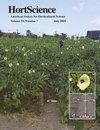评估黄瓜(Cucurbita pepo)植物引种品系对葫芦科黄萎病病毒和葫芦科叶片皱缩病毒单一感染的抗性
IF 1.5
3区 农林科学
Q2 HORTICULTURE
引用次数: 0
摘要
在过去几十年中,粉虱传播的病毒已成为美国葫芦生产的主要威胁。葫芦萎黄病毒(CCYV)、葫芦黄色发育障碍病毒(CYSDV)和葫芦皱叶病毒(CuLCrV)是包括黄南瓜(Cucurbita pepo)在内的葫芦科作物中由节肢动物传播的主要植物病毒。这些病毒的症状包括叶脉间萎黄病、萎黄斑点、叶片变黄和卷曲。对影响植物的特定病毒进行评估具有挑战性,因为在自然感染的田地里,混合感染非常普遍。为了设计一种基于育种的高效管理方法,在温室中筛选了两个郫县豆瓣品系(郫县豆瓣 171625 和郫县豆瓣 171627),以评估它们对 CCYV 和 CuLCrV 单个感染的抗性。在两个单独的试验中,这些品系与易感栽培品种 Gentry 进行了比较。与 PI 171625 和易感栽培品种 Gentry 相比,当植株感染 CCYV 时,PI 171627 表现出症状延迟、病毒载量减少和疾病进程曲线下面积(AUDPC)较小。然而,两种基因型和商业品系的 CuLCrV 的病程曲线下面积相同。基因型 PI 171627 的症状延迟且较轻,有可能为育种计划提供抗 CCYV 的来源。未来的研究需要了解这种反应的基本机制。本文章由计算机程序翻译,如有差异,请以英文原文为准。
Evaluation of Plant Introduction Lines of Yellow Squash (Cucurbita pepo) for Resistance against Single Infection of Cucurbit Chlorotic Yellows Virus and Cucurbit Leaf Crumple Virus
Whitefly-transmitted viruses have emerged as a major threat to cucurbit production in the United States during the past several decades. Cucurbit chlorotic yellows virus (CCYV), Cucurbit yellow stunting disorder virus (CYSDV), and Cucurbit leaf crumple virus (CuLCrV) are the main arthropod-borne plant viruses in cucurbit crops, including yellow squash (Cucurbita pepo). Symptoms of these viruses include interveinal chlorosis, chlorotic spots, yellowing, and curling of the leaves. The evaluation of specific viruses affecting a plant is challenging because of the prevalence of mixed infections in naturally infected fields. To devise an efficient breeding-based management approach, two PI lines (PI 171625 and PI 171627) were screened in a greenhouse to assess their resistance to individual infections of CCYV and CuLCrV. These lines were compared against a susceptible cultivar Gentry in two separate trials. PI 171627 displayed delayed symptoms, a reduced virus load, and a smaller area under the disease progress curve (AUDPC) compared with PI 171625 and susceptible cultivar Gentry when the plants were infected with CCYV. However, the AUDPC for CuLCrV was the same for both genotypes and the commercial line. Accession PI 171627, which displayed delayed and milder symptoms, could potentially provide a source for resistance against CCYV for breeding program. Future research is needed to comprehend the underlaying mechanism to understand this response.
求助全文
通过发布文献求助,成功后即可免费获取论文全文。
去求助
来源期刊

Hortscience
农林科学-园艺
CiteScore
3.00
自引率
10.50%
发文量
224
审稿时长
3 months
期刊介绍:
HortScience publishes horticultural information of interest to a broad array of horticulturists. Its goals are to apprise horticultural scientists and others interested in horticulture of scientific and industry developments and of significant research, education, or extension findings or methods.
 求助内容:
求助内容: 应助结果提醒方式:
应助结果提醒方式:


